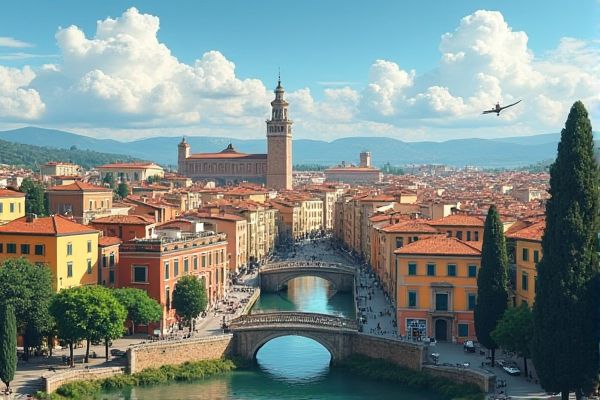
Transportation and commuting in Italy: Extensive train network: Trenitalia and Italo services. Metro systems in major cities: Rome, Milan, Naples. Regional buses: connect small towns, rural areas. Car rentals available: international and local companies. Driving requirements: valid license, insurance needed. ZTL zones: restricted traffic areas in cities. Taxi services: metered fares, authorized taxi stands. Car-sharing programs: Enjoy, Share Now, BlaBlaCar. Limited parking: costly in city centers. Biking culture: bike-sharing systems, dedicated lanes.
Extensive train network: Trenitalia and Italo services.
Italy's extensive train network is primarily operated by Trenitalia and Italo. Trenitalia, the main state-owned operator, offers high-speed services and regional trains, connecting major cities like Milan, Bologna, Florence, Rome, and Naples. Italo, the first private high-speed railway company, operates on routes such as Turin to Venice and Milan to Reggio Calabria, offering three classes of service with modern, sustainable trains equipped with free WiFi and other amenities.
Metro systems in major cities: Rome, Milan, Naples.
The metro systems in major Italian cities vary in scope and history. Rome's Metro, the oldest in Italy, operates with three lines (A, B, and C) serving 73 stations over 60 km, while Naples' Metro has three lines (1, 6, and 11) with 30 stations. Milan, though not detailed here, also has a comprehensive metro system, but the focus is on Rome and Naples, highlighting their extensive networks, daily ridership, and ongoing expansion projects.
Regional buses: connect small towns, rural areas.
Regional buses in Italy connect small towns and rural areas within specific regions or provinces, offering frequent and extensive services. These buses are crucial for locals and travelers alike, although they can be slow due to numerous stops and limited amenities. For more detailed insights on navigating these routes, visit Italy Explained, a resourceful guide that elaborates on bus travel within the country.
Car rentals available: international and local companies.
For those planning a trip to Italy, selecting the right car rental service can enhance the convenience and enjoyment of the journey. Noleggiare stands out as a quintessential local option, proudly offering meticulously checked cars and vans through its 61 locations across the country. This makes it an excellent choice for holidays and business travel in major Italian cities. Alternatively, the global presence of Enterprise Rent-A-Car provides travelers with a wide array of vehicles, from compact cars to SUVs, backed by award-winning customer service. For a comprehensive view, KAYAK compiles information from both international giants like Sixt, Avis, and Hertz, as well as local providers including Target Italy and GREEN MOTION, helping users find detailed information on rental costs, popular destinations, and available vehicle types.
Driving requirements: valid license, insurance needed.
Driving in Italy requires you to be at least 18 years old and in possession of a valid driving licence. Important documents to carry include the registration certificate, driving licence, and an insurance policy. For non-EU drivers, there are additional prerequisites such as possessing an international driving licence or a sworn translation of your current licence. It is also necessary to carry a green card or a temporary border insurance policy. For more detailed information on the rules and regulations, visit the official Italia.it website.
ZTL zones: restricted traffic areas in cities.
ZTL (Zona a Traffico Limitato) zones in Italy are restricted traffic areas situated in historic city centers, carefully designed to reduce pollution and enhance pedestrian safety. Only authorized vehicles, such as those belonging to residents or possessing special permits, are granted entry into these zones. These areas are active during specific time slots and are monitored by cameras to enforce compliance effectively. To learn more about these zones and their regulations, you can visit the Lurento website for detailed information and guidance.
Taxi services: metered fares, authorized taxi stands.
In Italy, taxi services operate with metered fares, and it is crucial to ensure the meter is set to "Tarrifa 1" for trips within city limits. Authorized taxis can be found at designated taxi stands, marked by official emblems, and it is advisable to avoid taxis that approach you directly, especially at airports and train stations. For a comprehensive guide on this topic, visit Grand Voyage Italy.
Car-sharing programs: Enjoy, Share Now, BlaBlaCar.
Enjoy is a widely recognized car-sharing service in Italy, spearheaded by Eni in cooperation with Fiat and Trenitalia. This service provides a fleet of Fiat 500 cars available for rental with competitive rates that include driving and parking costs, alongside insurance, maintenance, fuel, and parking expenses. Meanwhile, Share Now offers a unique experience in the realm of hourly car rentals. Their flexible rates allow for seamless parking in designated areas at no extra charge, all managed conveniently through a smartphone app. On the other hand, BlaBlaCar operates not as a traditional car-sharing model but as an online marketplace for carpooling. It connects drivers and passengers across cities and incorporates a commission-based model, extending services with BlaBlaBus for intercity travels.
Limited parking: costly in city centers.
In Italy, particularly in city centers like Rome, parking is limited and costly. With prices ranging from 4 to 8 euros per hour and daily rates up to 31 euros, it highlights the financial burden and scarcity of parking spots. For those looking for convenient parking solutions, Parclick offers a range of options to ease the stress of finding a spot in such a busy city.
Biking culture: bike-sharing systems, dedicated lanes.
Italy's biking culture is increasingly supported by advanced bike-sharing systems, such as BikeMi in Milan, which boasts over 5,000 mechanical bikes and 1,000 e-bikes across 325 stations, augmented by integrated software solutions that enhance user convenience and sustainability. Dedicated bike lanes and infrastructure development, particularly in cities like Milan and Bologna, are on the rise, with the Italian government investing heavily to expand bike paths and make cities more bike-friendly. These efforts are exemplified by projects like the Urban Sharing initiative, demonstrating the nation's commitment to promoting sustainable transport and improving urban mobility.
